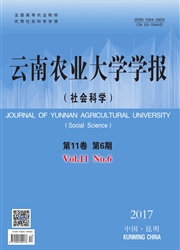

 中文摘要:
中文摘要:
水稻品种多样性的种植方式对控制稻瘟病非常重要,但对其作用机理的了解甚少,其中,品种间遗传阻隔效应是众多假说之一。为验证水稻多样性混栽种植模式下,品种组合主栽和间栽的品种遗传分化水平对其田间抗稻瘟病效果的影响,本研究建立了利用插入/缺失(InDel)中性分子标记快速和准确检测水稻品种间遗传分化的技术方法。该方法可以对主栽和间栽品种之间的遗传分化系数(GDI)进行检测和定量描述,其变化范围在0.00~1.00之间,GDI数值越高表示品种间遗传分化水平越高。利用GDI结合云南省在10年内广泛用于多样性种植的主栽和间栽水稻品种组合,筛选出19对品种组合进行其GDI与抗稻瘟病防治效率相关性分析的田间试验。根据对各组合品种田间稻瘟病发生情况的调查发现,不同搭配组合在田间所表现出的稻瘟病防治效果存在很大差异。进一步分析的结果表明,主栽和间栽品种的GDI与其田间的稻瘟病防效具有显著正相关性(R2〉0.92,P〈0.01),验证了在多样性混栽种植模式中,水稻组合品种间的遗传分化水平对其田间抗稻瘟病效率有显著影响的遗传假设。该发现不仅揭示了水稻多样性种植模式下,主栽和间栽水稻品种之间遗传分化影响其田间稻瘟病防效的遗传机制,还为混合间栽中不同水稻品种搭配组合的选择及对其田间生产中稻瘟病发生的预测提供了实用技术。
 英文摘要:
英文摘要:
The utilization of varietal diversity of rice under an intercropping mode is proven to be effec- tive for control rice blast diseases. However, the underlying mechanisms of such blast control from varie- tal intercropping are still not clear. Among the other hypotheses, we propose one that genetic divergence of intercropped rice varieties plays a roles in enhancing resistance rice varieties to blast diseases. To test this hypothesis, we developed a rapid, accurate and effective method to determine the level of genetic divergence between rice varieties using neutral molecmar marKer~ ~ ~,,L,~ j. tively determine the level of genetic divergence index (GDI) , ranged hypothetically between 0. 00 ~ 1.00, between the intereropped varieties. A large number of widely used rice varieties for intercropping in Yunnan were examined for their GDI using the InDel markers. We selected 19 varietal combinations with either high or low GDI for field experiments to determine the correlation between genetic divergence of intereropped rice varieties and their efficiency of resistance to rice blast diseases in the field. Results from field experiments indicated significant positive correlation ( R2 〉 0. 92, P 〈 0. 01 ) between GDI of intercropped varieties (major and minor) and their efficiency of blast control. Rice varieties under the intereropping mode with higher genetic divergence level demonstrated a significant impact on their effi- ciency of resistance to rice blast in the field. This finding has its significant implications not only for un- derstanding the underlying mechanisms of varietal diversity for blast control in rice, but also for predic- ting the possible field performance of resistance to rice blast in the field.
 同期刊论文项目
同期刊论文项目
 同项目期刊论文
同项目期刊论文
 期刊信息
期刊信息
